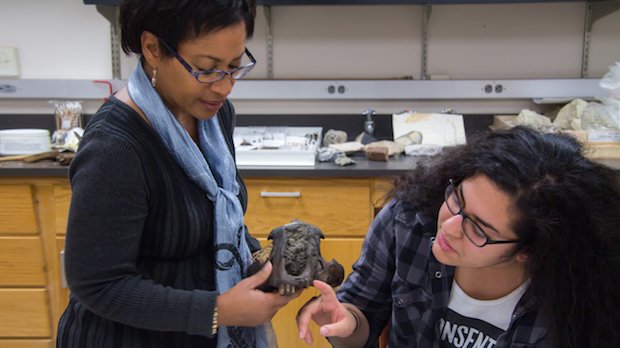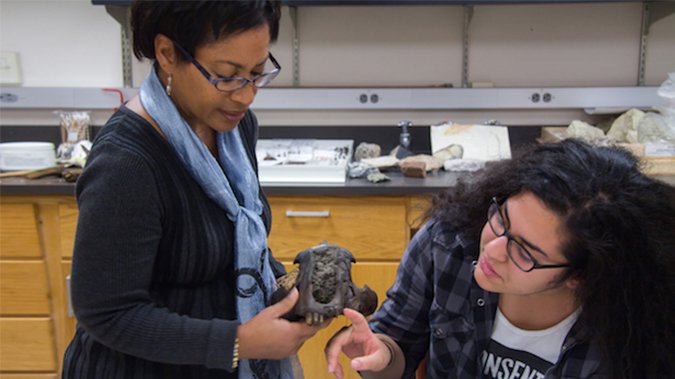Geoscience is an exciting career field within the overall STEM economy that is
expected to grow significantly over the next eight years . If President Obama’s Educate to Innovate initiative is any indication, government and industry leaders are concerned today’s students won’t be prepared for these careers. Moreover, aNOVA spoke with a geoscientist who believes earlier exposure to the subject of geology could impact this diversity gap. Lisa White has over two decades experience in science education outreach to urban communities, and was recently a guest scientist on the NOVA series, Making North America , appearing in episodes one (“Origins”) and three (“Human”) . She is the Assistant Director of Education and Public Programs at the University of California Museum of Paleontology (UCMP), and was also a professor of geosciences at San Francisco State University for 22 years. Lisa described her path to geology and offered some steps that teachers can take to attract diversity—and students in general—to the geosciences at an early age.
How did you become interested in geology, and what convinced you to pursue it as a career?
As a child growing up in San Francisco near the California Academy of Sciences, I always enjoyed the museum’s exhibits on rocks, minerals, and fossils. My attraction to science started there, but my interest in geology developed somewhat later in my educational life. I was a junior in college (at San Francisco State University) when I enrolled in a geology class as a general education requirement. I was really drawn to the subject matter and received encouragement from the instructor to pursue it. After that course, I had an opportunity for a summer internship at the U.S. Geological Survey in Menlo Park, CA. That provided me with access to professional geoscientists and greater familiarity with the discipline in a way that completely transformed my undergraduate experience. I not only decided to select geology as my college major after that summer, but I was convinced the profession held great career potential.
What do you believe is the greatest challenge to getting students, especially those from underrepresented communities, excited about geology?
Science has an image problem with certain communities and the lack of familiarity with the geosciences, in particular, is an enormous challenge. Student preparation in Earth science is hindered by many factors—from a lack of geoscience course offerings in high school to the designation of geoscience as a non-laboratory science for college-bound students to little national support to teach geoscience at the AP level. Prior to college, students are less likely to have any direct experience in the geosciences—leading to missed opportunities for us to draw students early to the major. Geology is often described as a “discovery science”—a science that many individuals have little or no exposure to before college. That was certainly my experience. I knew close to nothing about the discipline until I took that geology course for a general education requirement in college and I really connected with the subject.

Lisa White and UC Berkeley senior Armita Manafzadeh, one of the many students White mentors, examine California’s state fossil, the saber-tooth cat, or Smilodon fatalis.
How can teachers and school administrators help increase diversity in the geosciences?
Students who are underrepresented in the geosciences benefit from earlier exposure to the subject and to the career opportunities that it provides. Geoscience education researchers often cite the “critical incident”—a profoundly positive experience in a student’s life—that sparks interest in the geosciences. This could be a certain course, a field trip, or a museum visit.
You have focused so much of your efforts on issues of diversity in sciences and STEM careers. Are you seeing progress in this area on a national scale?
When I reflect on my own career, my professional experiences, and the collaborations I have developed to increase diversity in the geosciences and in STEM disciplines, I am pleased with the greater awareness and higher literacy about geoscience topics. I think the geoscience community continues to be more supportive and inclusive. But we have not moved the needle as much as we’d like with measurable increases in the number of African American, Native American, and Latino geoscientists .
What are effective strategies that can be used to draw students to Earth science?
As a student I assisted on USGS field mapping projects in California, Alaska and New Mexico, and was introduced to the many applications of paleontology. The study of fossils and the fossilization process helps students understand biology, the carbon cycle, where we get our oil, and even climate change. So I try to re-create similar geoscience field-and lab-based experiences for high school students so they can discover the geosciences at a much earlier age than I did. I’ve done this through geoscience education programs such as SF-ROCKS (Reaching Out to Communities and Kids with Science in San Francisco) and METALS (Minority Education through Traveling and Leaning in the Sciences).
I encourage any Earth science teacher to get students outside as much as possible to make observations and engage in science in natural surroundings. Field trips require resources, but simple things can be done in a school playground or a nearby park. For example, I worked with a school in San Francisco that had an exposed rock outcrop in the schoolyard. I helped teachers create an activity on understanding the rocks and stratigraphic relationships in the field. One of the best scientific skills to develop in students is the process of scientific inquiry: asking questions, making observations, and sharing ideas. This can be done anywhere in the natural world, by looking at leaves on trees, insects in the yard, clouds in the sky, etc.
What if students don’t think geology is relevant to their lives?
I would say watch NOVA’s Making North America and be totally inspired by the landscapes, the environment, and the new questions and information scientists seek to understand! Students really should know how major geological events work, because these events affect us all. For example, when I was teaching introductory geology and oceanography to college students in the 1990s, misconceptions about tsunamis were frequent. Most of my students thought tsunamis were just a type of tidal wave, and they didn’t always make the connection between seismic movement and displacement of ocean water. Many had no direct connection or experience with tsunami events. Few large ones have occurred in their lifetime or been reported on in local media with any detail, and they saw little relevance to their own personal experiences or that of others. This certainly changed after the 2004 Indian Ocean and 2011 Pacific Ocean tsunami events, because the societal and global impacts were quite dramatic.
How is digital media changing how we teach Earth science?
Digital media is contributing to a rich array of visualization tools, helping transform how students view Earth and how they understand Earth systems and the processes shaping the Earth’s surface and interior. Google Earth is a fantastic tool frequently used at many learning levels—from high school to upper-level college courses. The majority of Earth science textbooks have online components and digital media sites to support the way the information is presented. So students of all ages can really dive into the materials and better conceptualize how geological processes typically operate on timescales of millions of years. Speeding up geological time to enhance teaching and learning in Earth science is tremendously helpful!
Are you excited about any other educational resources that bring geology to life?
At UCMP we have a number of well-regarded online resources that support the teaching of evolution ( Understanding Evolution ), and the nature and process of science ( Understanding Science .) In mid-2016, we will launch a new web resource, Understanding Global Change, designed to provide K–16 educators and the public with high-quality resources on the causes and consequences of global change. And another excellent resource is the InTeGrate project based out of Carleton College, which aims to improve undergraduate geoscience education by placing it within the context of socially relevant topics, environmental challenges, and resource sustainability.
—
Lisa White is one voice among a chorus of those working to address the diversity gap in the geosciences. For over twenty years, a consortium of colleges in the South and Midwest led by Fort Valley State University (a historically black university) has focused on increasing geoscience graduates through a program called CDEP, with positive results. The aforementioned Carleton College InTeGrate project also has an initiative called “ Why Focus on Diversity ,” which provides advice and links to educator resources—part of its overarching goal to recruit geoscience majors at an earlier age. Similar initiatives are happening at colleges in Michigan , Tennessee , and California.
Towards that goal, NOVA and PBS offer a number of free educational resources: All three Making North America episodes can be streamed here , and NOVA’s collection of Earth science educational resources is available on PBS Learning Media .



